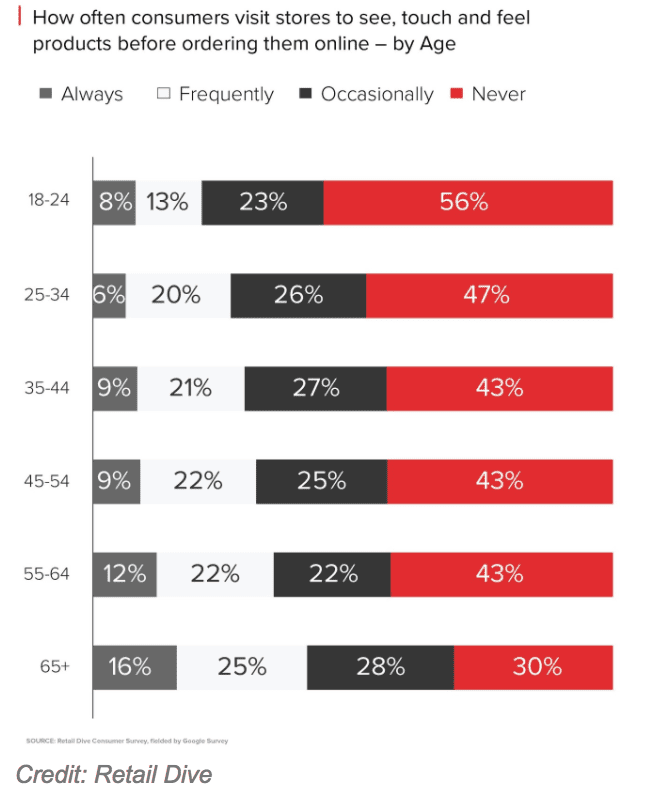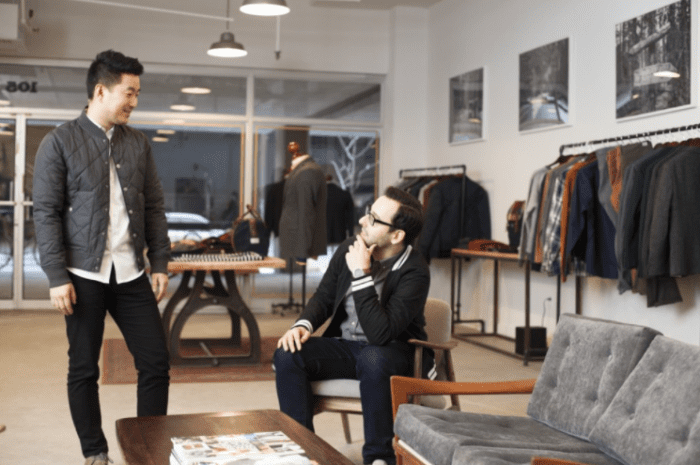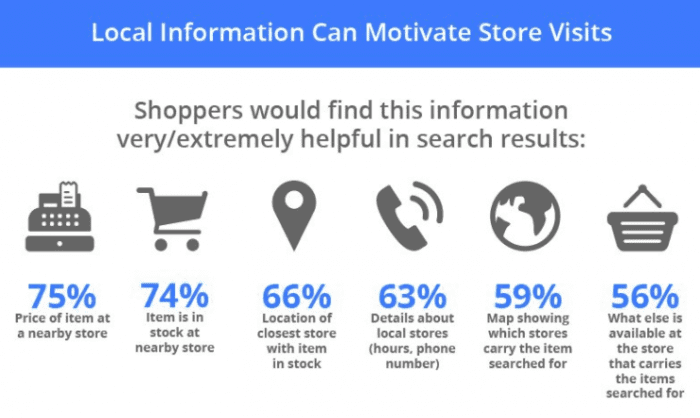When it comes to selling online, a good marketer is doing their best to optimize the marketing funnel. But most often they do the online part of the job - supporting the customer on their way to the shopping cart
It is not new that we make our decisions emotionally, so often ignoring the rational part of the purchase while analyzing the product. When surfing online for a new pair of pants, we will buy only them, most likely.
But what if we come to the store and try a new pair of pants on?
What if walking between the aisles we will stumble upon an amazing blazer and a cool shirt? Well, we will try them on also, since we are already heading to the dressing rooms. More experimentation, assisted purchasing, great atmosphere, people around...
The growth of online commerce is not about the death of offline stores.
It is about their reincarnation.
Download FREE Resource – 10 ecommerce mistakes
Explore the top 10 ecommerce mistakes and how to avoid them. Ecommerce is a fast-moving environment and we actively keep our mistakes up to date so you’re always making the most of your marketing
Access the
While making the purchase easy by pressing a few buttons on the keyboard, marketers so often forget about making an impression offline.
Analyze beforehand
As a recent studies show, more than half of the customers prefer to interact with the items physically before buying them. But this hugely depends on the age of a buyer, gender, prices, and type of the products you sell.
Older generation uses more traditional ways to buy and younger people tend to buy more online.

Engage them with an app
Establishing omnichannel for eCommerce business, you also need to keep your online and offline strategy complementary to each other.
Rent the Runway makes it possible to check in the fitting room and to leave the feedback in your app after trying something on. All the data is saved in the clients’ private profile and is available for the marketer’s analysis. They also empower in-store sales team with this data, making it product recommendations much more tailored to the wishes and needs of every buyer.
Thanks to iBeacon you can detect where your customers are in the store and send them personalized messages.
The more shoppers are used to interact with the brand online via apps, the easier it will be to encourage them to share their purchases on social media.
Personalize everywhere
Making an app a personal assistant just as a real human - isn’t that futuristic a bit?
But wait, you can go even further. Detect when your clients pass your store and send them messages and encourage them to purchase, making a with a push notification.
Some stats prove that 65% of buyers search info while being in the store, and half of them goes to the retailer’s website or an app. Why?
Mostly, they are looking for the best offers and reviews of the chosen products. Easy to use app or chatbot may come very handy in the situation when a shopper is standing in a store and looking for more info.
Apart from telling more about each product, you can personalize the experience of a buyer. Send him a notification about local offers in the nearest to his home or work store. The main goal is to make the experience in your store and outside of it on mobile and desktop united.
Looking at the whole situation from the global point of view, bringing online to offline is much more than implementing some mobile app features. It is about a transformation of the functions of the brick and mortar retailers.
Creating a context
The best way to leave a trace in somebody’s mind is to meet them in person and do something together.
That is what traditional ecommerce leaves out.
You can not meet the people behind the brand, try the chosen products on or just feel what the brand is about with all your senses if you use only their online website.
But when you come to the store, you get much more information about the brand - absorbing every single molecule of the space.
You meet the assistants.
And intentionally or not, you admit how they behave themselves - smiling or being formal, hospitable or just doing their work.
You see the design of the store, how clean it is, how much light comes in, how easy and relaxing you feel there.
That makes the whole picture about the brand.
Now imagine you are selling menswear, and decide to meet your clients in person in your own store.
If you are selling premium clothes, you may enrich the experience with cafes, lounge spaces and barber shops just as Frank And Oak did.
People will associate themselves with a certain lifestyle and will try to invest in it more if they like it. They will go for more expensive clothes and accessories if they prove their high-status, belonging to a certain community.
One of the biggest sports brands in UK Active in Style also meets shoppers offline, organizing numerous meetups and successfully taking online to offline.

Image from marketingmag.ca
If your primary channel is online, you will see how your audience splits into the categories:
- Those who keep buying online
- Those who come to your store and then buy online
- Those who will research the information online and buy mostly offline
And you need to treat them all differently. Setting up as many touch points as possible will allow you to create a network of convenient shopping. Going from online to offline is often named O2O.
Mostly, the clients will buy from you online, but those who will decide to come to your physical store will be pleasantly admired with the level of the service. If you will manage to create a buzz, delivering exceptional services to a limited amount of people, you have great chances to go viral.
Especially well it works for the tailored products such as clothes made on order.
If you walk into Nordstrom, you will meet charming stylists, making the purchasing process much more exciting. Moreover, you can drink fresh juice and make a manicure there.
Pickups
81% of shoppers prefer to look for the information about the products online but buy them offline. According to Think With Google three out of four buyers who find the needed information in search results useful are more willing to visit the physical store.
Here is info about stores and products to check:

Image from https://www.thinkwithgoogle.com
Getting rid of the huge inventory in the store will let you focus on the customer service. The assistants will no longer need to manage and carry huge piles of clothes if you will create a “try on offline and buy online” store. In this case, you let the shoppers choose the best look in the store, pay for it online and get the items shipped for free.
Researching online, you need to attract customer attention and give him all information on the product. More reviews, rating and photos of the product from the different angles - it all helps.
Costs
It all sounds fantastic, but what about the costs to build a store and teach the assistants your values and customer service?
Surely, you need to keep that in mind. But while calculating, bear that:
- Bonobos claim that clients who have had a human experience in the store will buy 75% more than those who didn’t.
- Warby Parker, one of the successful eyewear retailers, operating only online opened more than 50 stores. Each store is decorated in a unique way so that people love sharing the word about the brand. Some of them are the most profitable in the country, which makes us think about “rebirth” of the in-store experience.
While big and classic retailers are closing their stores, smaller online sellers are starting their way in the brick and mortar complementary businesses and succeed.
To wrap up
Human interactions are getting rarer and we no longer need to get out of the house to get everything we need. In this world of online transactions, every human transaction counts.
Creating a physical store with experienced associates is a great way to enrich the shopping experience and build brand loyalty.
Balancing between digital and offline resources, you will need to test a lot and learn about customers as fast as possible. However, the revolution of online stores going offline and creating sensual human experiences has begun. And it is up to you - to benefit from it or shy away.

Thanks to Mary Borysova for sharing their advice and opinion in this post. Mary is CMO at
OpsWay, a website and app development company. Mary builds the bridge between eCommerce businesses and website developers. When not creating the OpsWay eCommerce ecosystem, she travels and enjoys sunset runs. You can connect with her on
LinkedIn.






 Thanks to Mary Borysova for sharing their advice and opinion in this post. Mary is CMO at
Thanks to Mary Borysova for sharing their advice and opinion in this post. Mary is CMO at 



